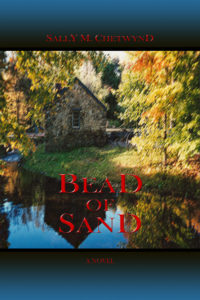
Monday, December 7, 2020
Legacy
Perhaps you will indulge me as I dedicate this issue to my mother, who died the week before Thanksgiving at the age of ninety-six. Some of you have already received this news, as I’ve notified close friends and relations. Any of you who were her friend already knows what a chunk her passing takes out of our lives. But the hole left behind is brimming with her love and warmth. She lived a long life, full of good health, good will, and good humor.
Something I noticed six years ago, while going through family pictures to make a collage for Mother’s 90th birthday party, was her eternally youthful face. I came across a photo of her at age 14, out cross-country skiing (below left). She looks at the photographer with a half-smile as if to say, “Are you coming?” She looks no different in that picture than in the one taken 76 years later at the party (below right). Yes, finely rimpled, but no less sparkle in her eyes.
(What do you think?)
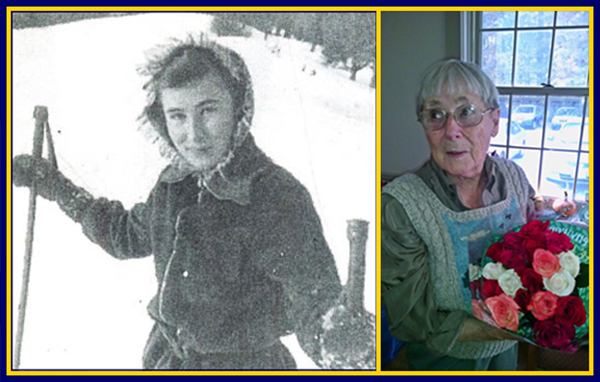
Age 14 (1939) Age 90 (2014)
Lorraine B. Morong
October 24, 1924 – November 18, 2020
Some people seem never to age, people like Dick Clark, America’s perpetual teenager and popular music icon (and no, he never had plastic surgery). Sometimes I ponder how that happens. No doubt, inherited genes make a big difference. Some of Mother’s relatives nipped at the century mark. Life-long awareness of maintaining good health counts.
Some of this must be attributable to a positive attitude, too, receiving what life doles out with practical good sense and bonhomie. And some of it must be generated by a drive to focus deep-seated interest in others rather than in oneself, to share one’s resources, of whatever ilk, rather than to hoard oneself selfishly.
Dick Clark (1929-2012) wrote that the real secret, regardless of your genetic inheritance, is to think young, stay active and make the best of what you have. This sounds like a blueprint of Mother’s life. (Maybe he got the idea from her … )
Whatever the reasons, my mother certainly has had a profound effect on far more individuals than her family alone. We have all been blessed!
She’s not really gone, not in spirit. She’s stepping into a new phase of life. I can hear her now, if I listen carefully: “Come on! Let’s go!”
Another adventure awaits …
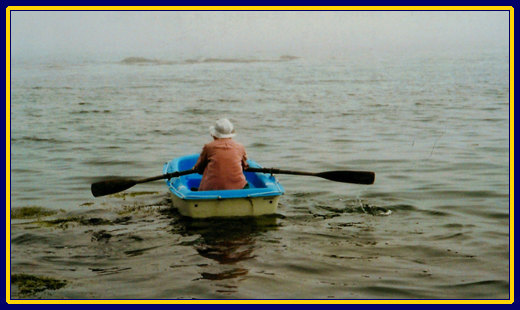
Lorraine at 89, going out to tend her boat
Sally M. Chetwynd
Brass Castle Arts
Email Me | Visit Website | Sign Up For Newsletter
To Tease Your Mind
Just because you can eat bread off the top of my head
doesn’t mean you can push me around.
and
I’m only short on one end.
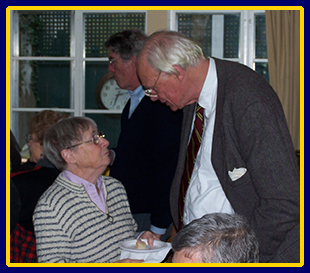
Lorraine B. Morong
with friend Brewster Jackson
A towering figure at five feet tall with a fighting weight of 110 pounds, this diminutive dynamo made an indelible imprint on everyone she met. My husband Phillip often referred to her as the Energizer Bunny. What kept her going was an intense interest in everything and everyone around her. She had friends in every age group – from the toddler great-grandchildren to contemporaries her own age, and some older. WHO you are was more important to her than WHAT you are. As a result, her collection of friends ran an impossibly broad gamut, professionally, socially, and culturally.
Natterings & Noodlings: Shouldering the Mantle
Only a few days after my mother Lorraine died, I felt the mantle of Official Family Writer settle onto my shoulders. Although I have two published novels and a smattering of short stories, poems, biographical profiles, and so forth, I am not the only writer in the family. I believe I inherit this mantle because I am the only one of my generation who actively pursues writing. If any of my brothers, however, chooses to dispute my ascension (such as it is), I will gladly share it. Two of them are able wordsmiths in their own right.

Brother Number Two has produced a number of short stories, at least one of which has been printed in an anthology, and has a couple of novels in the works. Brother Number Four’s work is scientific and scholarly; his articles on geology and mineralogy have appeared in trade and hobby magazines.
No matter who takes on this role, each of us siblings has our mother’s legacy to uphold, she whose sheer volume of published work far outstrips anything we collectively have produced. She was always meticulous to collect background information that clarified or substantiated her notes, making her a true professional in journalism. She often shared her “tribal knowledge” with cub reporters who recognized that her longevity in the field meant that she held the history of any given local issue at hand.
Lorraine’s column appeared every week in the newspaper since 1960, when she first took on the job of local correspondent for South Berwick, ME, reporting to the Portsmouth [NH] Herald. She later covered Durham, NH, including police reports and court proceedings, and sent her material to the Tri-Town Transcript (covering Durham, Lee, and Madbury).
Longest and most recently, she covered Madbury news for Foster’s Daily Democrat of Dover, NH, attending the meetings of the Selectmen, Planning Board, Historical Society, Conservation Commission, Zoning Board of Appeals, Water Board, Community Club, Friends of Madbury Library, and First Aid Stabilization Team (F.A.S.T.). Her advocacy for this last one earned her the nickname “Ma FAST.”
This number of active civic organizations is surprising for a town of about 2,000 residents. It was not unusual for Lorraine to attend a meeting every night of the week. She also belonged to and supported a number of other groups and causes, like the local writing group and preservation of the Great Bay estuary.
Early on, my brothers and I depended on our mother to type up our school reports. It wasn’t long before she mandated that we each take at least one semester of personal typing in high school, so we could type our own papers, which gave her fingers a break. There was no arguing with her point that this skill would serve us well as adults. I doubt my brothers were thrilled and neither was I. Personal Typing I equated Dullsville Central, but I did learn the basics.

This is the vintage of typewriter we kids learned on, at school and at home.
The course has served me well. In the twenty years between college and affordable personal computers, I pounded out (and one had to pound those old manuals) endless meeting minutes for groups I belonged to, endless drafts of novels (two of which I finally finished many years later), endless essays, poetry, articles, letters, research papers, biographical profiles – you name it. I plumb wore my poor typewriter down to a nubbin.
I may have inherited great physiological genes from my mother, and great word-craft genes, but I did not inherit her newspaper genes. She ran a clipping service for ten years, which put me through college. The local and regional news was her lifeblood. On the other hand, I can’t say that I’ve ever read an entire newspaper from front page to back, not even in a waiting room. I just don’t have the least affinity for the news. But that never kept Lorraine from clipping articles of interest to me.
We shared great amusement over two specific things from the papers – crazy headlines and crazy fashion photos. Headlines like “Woman Aided by Goose Committee Dies” had us in hysterics. The latest clothing styles had us in hysterics, too, the absurd outfits not resembling clothing in the least. I commented to her a few months ago that I really did miss the latest from Paris and New York – the papers no longer have a fashion section. Now how will we know of the hottest runway rags of the season?
Look what I just found, poking through an old manila folder labeled “silly Stuff:” one of Lorraine’s submissions to me (below left)! Compared to the right-hand one, it resembles clothing (sort of).
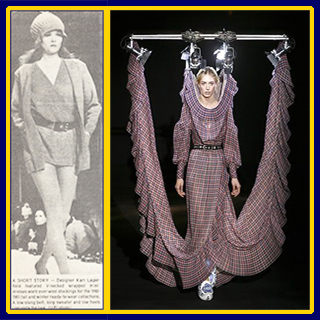
1980-1981 fall collection fall collection 2020
Look how far we’ve come … This is 40 years of progress?
Newspapers aside, I learned a great deal about writing, revision, and editing from my mother. I had excellent teachers in school, and English was usually my favorite subject. But Lorraine gave me in-depth, hands-on guidance. Besides her professional writing work, she contracted editing jobs on occasion, so I was exposed to that as well.
She was reluctant to be a beta reader for my first novel, afraid that she’d feel compelled to tell me it was great, even if it wasn’t, because she was my mother. She accepted the task, with the caveat that she didn’t promise to make any comments. She did, however, and most of them proved absolutely necessary.
An invaluable trick Lorraine taught me, never in any English class, was proofreading. Ideally, one person reads the text out loud to a second person, who also has a copy. One person can do it alone, reading the material aloud, although this is not as exacting. The text is read in a monotone, pronouncing each bit of punctuation, too. Here is an example:
Written text:
“What hath God wrought?” Morse tapped into the telegraph machine.
Proofreading (spoken):
open quotes – capital W – What hath – capital G – God – wrought – question mark –
close quotes – capital M – Morse tapped into the telegraph machine – period
This method ensures that nothing is glossed over by the eye alone, which is tired of looking at the piece. It is boring, but it does catch typographical errors, word repetition, tongue twisters, and so forth. The results make the tedium worth it. (Writing is similar to cleaning house: no one notices if you’ve done a good job, but they sure do if you haven’t.) You’ll never regret doing this on any of your work.
I learned a lot at home about how to do research, too. Besides purchasing the thirty fat volumes of Encyclopedia Americana for us to use for our school papers, its shelf sagging from the weight, my parents subscribed to meaty magazines like Scientific American and Popular Mechanics. From yard sales and auctions, they harvested issues of National Geographic dating to the turn of the century, the table of contents listed on black-&-white covers, long before the signature bold yellow cover with dynamic photos. I loved to pore through these for obscure nuggets of information that would impress my teachers on my broad coverage of the assigned subject.
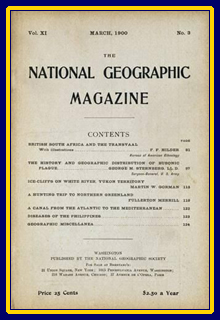
All in all, my writing heritage is well founded – bolstered and encouraged from childhood by both of my parents, supplemented with ceaseless reading. The house was (and still is) full of books of every genre. One of my mother’s favorite pastimes was attending the Dover Public Library’s annual book sale. Many of these long-since out-of-print, discarded books (often first editions) that she brought home, in paper grocery bags filled for the price of a doughnut, are on the market again, reprinted by Dover Publications [not related to the City of Dover, NH].
As you know from previous N&N newsletters, I find connections all the time between books and other documents, material that otherwise seems unrelated. It’s a great adventure. I thank my mother, the cornerstone of my life-long passion for the written word.
I wonder what Lorraine is reading now? Or writing?
Featured Website
Madbury Public Library
http://www.madburylibrary.org/
11 Town Hall Road, Madbury, NH 03823
One of my mother’s pet projects was the Madbury Public Library, an institution that did not exist until 2001. Lorraine was inspired to promote the establishment of a town library after the poor treatment that Madbury resident Sylvia Grimes received in 1999 from the UNH library in adjacent Durham. Sylvia was not allowed to borrow books for her research for the simple reason that she was not a resident of Durham, despite having matriculated at UNH. This air of superiority raised Sylvia’s hackles, Lorraine’s, and those of many others in town. After all, this was the library of a state university, not the exclusive library of the town of Durham.
In 2001, after a dedicated volunteer effort, residents of Madbury voted at town meeting to establish a public library. It incubated in a closet at the Town Hall, and hatched in 2003 to the Estes House, a town-owned ranch that the police department vacated when its new public safety facility was built.
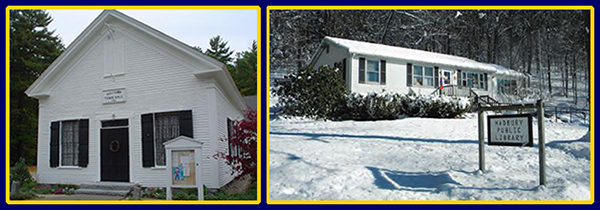
Town Hall, a closet within (2001-2003) Estes House (2003-2019)
first two homes of Madbury Public Library
A Capital Reserve Fund was established at the 2002 Town Meeting to start raising money. To avoid the encumbrance of a bond, residents added diligently to it at the annual town meetings. A number of citizens formed Friends of the Madbury Library, a designated 501(c)3 entity, which worked tirelessly through the thick and thin of the project. Their efforts were greatly supplemented by private donations from friends across the country. The Selectmen designated a parcel of land adjacent to the Town Hall for the new library.
While located in the Estes House, experienced and professional staff and volunteers created a first-class library with a wide variety of programs and activities. By early 2019, fund-raising, planning, and design were complete. Construction began on April 13, 2019, and proceeded through the summer and fall. Eight months after ground-breaking, on December 8, the new Madbury Public Library officially opened, paid in full, a remarkable feat for a very small town. Sadly, Sylvia Grimes couldn’t attend the Grand Opening; she was then in a nursing home. But Lorraine saw the completion of the project through and cut the ribbon for her.
 new Madbury Public Library (2019 – ) Lorraine (in aqua coat) at Grand Opening
new Madbury Public Library (2019 – ) Lorraine (in aqua coat) at Grand Opening
Word’s Worth
Oxford English Dictionary
mantle origin – Old English, Old French; dating from the 12th Century
- a loose sleeveless cloak of varying length
- a covering
- a kind of woolen cloth, a blanket
(and various other meanings, some obscure, some scientific)
Merriam-Webster.com
mantle origin – Middle English, from Anglo-French and Latin;
dating from the 13th Century
- a loose sleeveless garment worn over other clothes
- a figurative cloak symbolizing authority
- something that covers, enfolds, or envelops
- to cover with or as if with a mantle or cloak
- to become covered with a coating
- to spread over a surface
(and various other meanings, some obscure, some scientific)
(not to be confused with “mantel,” a shelf above a fireplace)
Conversations
Do you have comments or questions about this post? Let’s talk!
Happy reading! Happy writing!
Sources
Image: Lorraine at age 14 (photographer unknown, 1939)
Image: Lorraine at age 90 (Michael C. Ward photo)
Image: Lorraine vs. Brewster Jackson, fellow summer resident of Loud’s Island (Mark Tamaccio photo)
Image: Lorraine at age 89, rowing out to her boat mooring (Bennett Morong photo)
Image: pen and draft
https://joebuhlig.com/writing-articles-by-hand/
Bizarre fashions
Image: 1980-1981 fall collection, clipped by Lorraine from Boston Globe (UPI photo)
Image: 2020 fall collection:
https://www.reckontalk.com/weird-and-funny-fashion-show-trends-part-1/
Image: typewriter
https://www.etsy.com/in-en/listing/668744738/1937-royal-khm-typewriter-working
Image: National Geographic Magazine, 1900
https://www.allposters.com/-sp/Cover-of-the-March-1900-National-Geographic-Magazine-Posters_i14283434_.htm
Madbury Town Hall
https://en.wikipedia.org/wiki/Madbury,_New_Hampshire
Madbury Public Library – Images
Logo – http://www.madburylibrary.org/
Old – https://www.nhlta.org/ckfinder/userfiles/files/Newsletters/2019-20%20Winter%20Newsltr.pdf
New – https://www.facebook.com/madburylibrary/about/
UPI Archives “Dick Clark tells ‘secrets’ of youthful appearance”
https://www.upi.com/Archives/1981/03/03/Dick-Clark-tells-secrets-of-youthful-appearance/5347352443600/



